Facility Rental
Buffalo County has several meeting rooms available for community use. Whether you need to have a few people
sitting around a table, a meeting for 100 people, or an event that will be attended by 500, we may have a place for you.
Download the Rental Contract, fill this form out and send it in to get the rental process started.
For questions or additional information contact:
Nikki - (308)
236-1225 - nfriend@buffalocounty.ne.gov
Steve - (308) 236-1225 - facilities@buffalocounty.ne.gov
NOAA Weather-Ready Nation Ambassador
Buffalo County Emergency Management is now a NOAA Weather-Ready Nation Ambassador.
The Weather-Ready Nation Ambassador initiative is an effort to formally recognize NOAA partners who are improving the nation’s readiness against extreme weather, water, and climate events. As a Weather-Ready Nation Ambassador, your organization is committing to work with NOAA and other Ambassadors to strengthen national resilience against extreme weather.
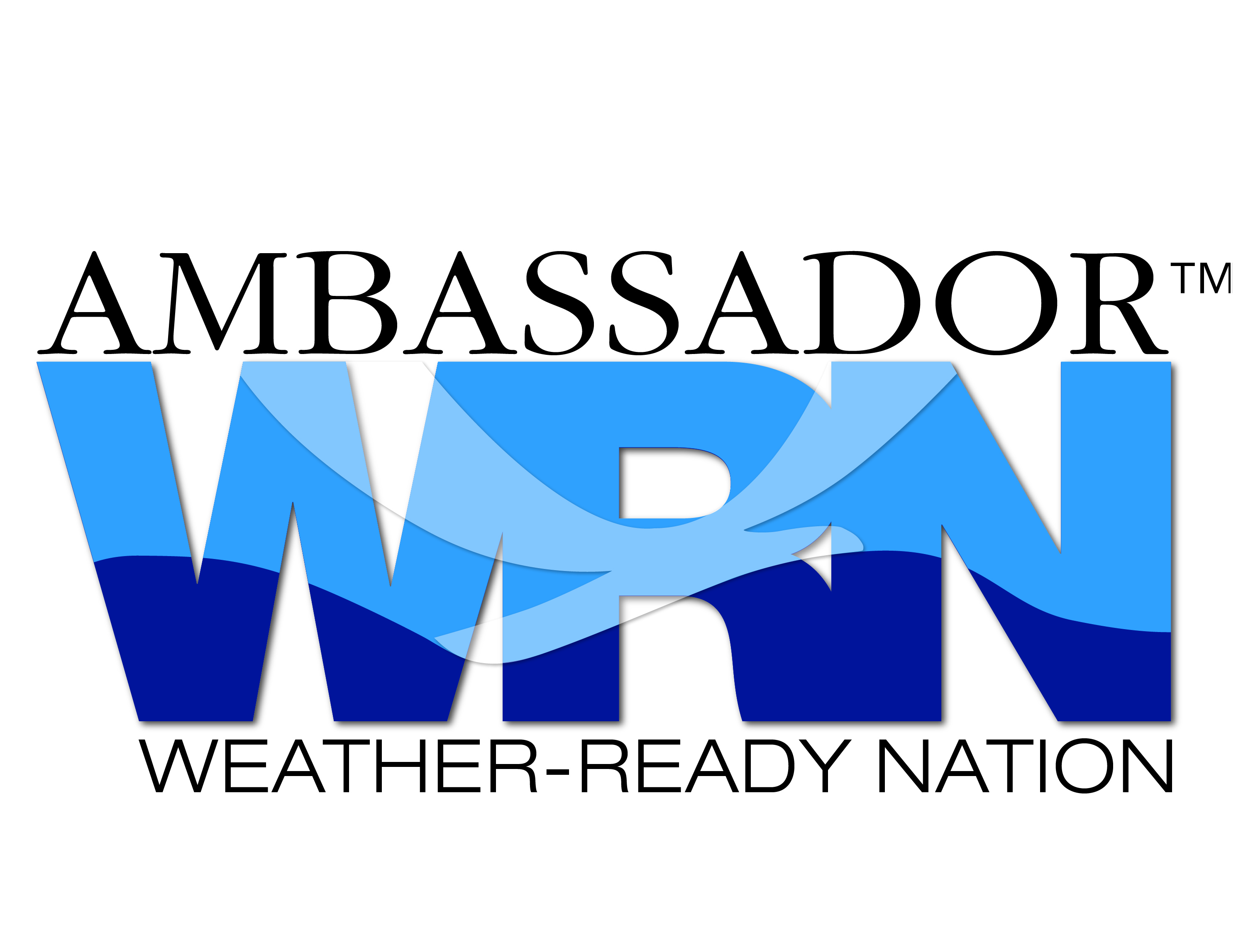 NOAA Weather-Ready Nation NOAA Weather-Ready Nation
Potential Shelter Locations
Domestic Violence FAQ
What is a crime of Domestic Violence?
A crime of Domestic Violence (DV) is any crime involving individuals who are currently or have had in the past an intimate and/or dating relationship. It may include a physical assault. It may also include, but is not limited to, the following types of cases: damage to property, theft, refusing a request to leave, violation of a protection order, disorderly conduct, disturbing the peace, etc.
A police report has been filed and the suspect was not arrested at the scene. What happens next?
If they were not arrested at the scene and the crime involves Domestic Violence (DV), the police report will be further investigated by law enforcement. If that further investigation reveals sufficient evidence to believe a crime has been committed, the police will give that information to the County Attorney’s office for review. If the police do not believe a crime has occurred or that there is insufficient evidence to proceed in a criminal case, no further action will be taken.
If the County Attorney’s office believes sufficient evidence exists, appropriate charges will be filed, which may include the prosecutor’s request of the County Court for an arrest warrant for the suspect.
A police report has been filed and the suspect was arrested at the time of the incident or arrested on a warrant, what happens next?
The next step is usually an arraignment hearing. Arraignments are generally done every weekday at 1:30 p.m. on the next business day after the arrest, excluding holidays. The Judge will tell the defendant what they are charged with and the possible penalties. They will be granted an appearance bond, which will require that they have no contact with their victim. That means they are not to visit, telephone, e-mail, text, or in any way communicate with their victim. The accused will have the opportunity to hire an attorney, or be appointed one if they cannot afford one. The defendant may enter a plea of guilty or no contest, and the next hearing will be a sentencing; or a plea of not guilty, and a trial date will be set.
The Judge issued a No Contact Order, what does that mean?
It is a condition of bond in all cases of Domestic Violence, issued by the Judge at arraignment that forbids contact with the listed victim, or victims, until the case is resolved. It is the policy of the Buffalo County Attorney’s Office to uphold and defend that “No Contact Order,” even if the victim does not wish one. The Defendant may be charged with an additional crime if he/she violates that order, and may also have his/her bond revoked or increased as a result of violating said order.
How can I find out if an offender is still in jail?
Contact VINE at 877-NE 4 VINE or (877) 634-8463, or online at www.vinelink.com.
I posted bond for someone, how do I get that money back?
If a Defendant can post the bond, it will be released to the Defendant, regardless of who posted the bond. The bond will be released upon the resolution to the defendant, unless otherwise ordered by the court.
What if I want to drop charges and/or recant the statements made to the Police?
Our office will not drop charges, generally speaking. Charges are filed by the State of Nebraska, not the alleged victim. It is the best interest of the State of Nebraska and the alleged victim to see that any person accused of Domestic Violence be held accountable for their actions. Domestic Violence poses a danger not only to the victim, but also to the victim’s family and society as a whole. The State of Nebraska has a “no-drop” policy to protect not just the individual victim and to ensure that there is no further violence perpetrated by the accused.
What will happen at a trial?
There are two types of trials: Jury or Bench. A Bench trial is decided by a judge only. A Jury trial is decided by a group of citizens. At both trials there is evidence presented. The witnesses will testify as to what they saw and heard. Evidence may include witness testimony, copies of 911 call recordings, photographs of injuries and the scene, hospital and doctor reports, telephone records, and more. The witnesses will be cross-examined. After all of the evidence is presented there will be a decision of guilty or not guilty.
Will I have to testify?
The majority of DV cases are resolved prior to trial by a plea agreement. However, if such an agreement cannot be reached, you will receive a subpoena that court-orders you to appear and testify at trial.
What could the potential sentence be upon a finding of guilt?
The sentence depends upon the crime charged. Judges have great latitude in sentencing offenders. They may order the defendant to pay a fine, be placed on probation, or serve time in jail or prison, or may order a combination of those things.
As a part of probation, a judge may order the defendant to pay restitution. In order for restitution to be paid, the defendant must be eligible to be placed on probation OR to have posted sufficient bond to pay the requested amount of restitution. Only those victims listed in a police report who have been reported to have damage to property may be given restitution. Victims may be required to submit a victim impact statement and documentation for any restitution they desire. If no restitution is at issue, a victim may, through a victim impact statement, tell the sentencing judge in writing how they feel about the event and what they think ought to be done with the offender.
How do I find out what time/date the trial will be?
Victims and witnesses will be personally notified in writing of the date, time, and location of the trial. Victims and witnesses will receive a letter and legal document called a subpoena that court orders them to appear on the date of trial. It is important to communicate with the prosecutor in preparation for trial.
What if I received a subpoena but cannot testify?
A subpoena is a legal document that court orders someone’s appearance. If that person choose to ignore the subpoena and does not appear, a judge may find them in contempt of court and issue a warrant for their arrest.
If you cannot appear for some legitimate reason, you should call the prosecutor assigned to your case and explain. The prosecutor may then ask the court to continue the trial or hearing, and there may be a hearing on that request. The hearing will be held in front of the judge assigned and the Defendant and his/her attorney will be present. Continuances are only granted in extreme circumstances.
What is my role in the case and how/when will I be contacted?
The Buffalo County Attorney’s Office encourages victims to be involved in the legal process. A member of our office or the Kearney Police Department Victim/Witness Unit will contact victims to let them know when a Defendant is scheduled to be arraigned, and also after the arraignment so that they have information as to future court dates, appearance bonds, and any other conditions of a Defendant’s release.
The prosecutor assigned to the case is also available to answer any questions a victim may have, and to consult with them regarding any potential plea agreements negotiated with the defendant’s attorney. The victim will be notified of any pending sentencing dates or other important hearings.
For information about the status of a case, call the Kearney Police Department Victim/Witness Unit at (308) 233-5263, or call the County Attorney’s Office at (308) 236-1222.
Where can I get help?
You are not alone in this process. There are several organizations that specialize in domestic violence issues that are waiting to help you through the process. The Kearney Police Department Victim/Witness Unit (308-233-5263) is here to provide support services for you. The S.A.F.E. Center also offers many resources for victims of domestic violence and their families.
How can I get a Protection Order?
If you are in fear of your safety, you may obtain a court order to prevent an individual from contacting you. Information and downloadable forms are available online. Or, contact the Buffalo County Clerk of the District Court to obtain them. The S.A.F.E. Center can be a source of information also. Finally, the Kearney Police Department’s Victim/Witness Unit can provide information.
Wireless Emergency Alerts
To enhance public safety, a free Wireless Emergency Alerts service is rolling out. WEA (pronounced “wee”) messages are text-like alert messages received by your mobile device during an emergency in your area. The purpose of WEA is to provide an increasingly mobile American public with a free and fast way to receive critically important information.
Frequently Asked Questions:
Why is this important to me?
Alerts received at the right time can help keep you safe during an emergency. With WEA, alerts can be sent to your mobile device when you may be in harm’s way, without need to download an app or subscribe to a service.
What are WEA messages?
Wireless Emergency Alerts (WEA) are emergency messages sent by authorized government alerting authorities through your mobile carrier. Government partners include local and state public safety agencies, FEMA, the FCC, the Department of Homeland Security, and the National Weather Service.
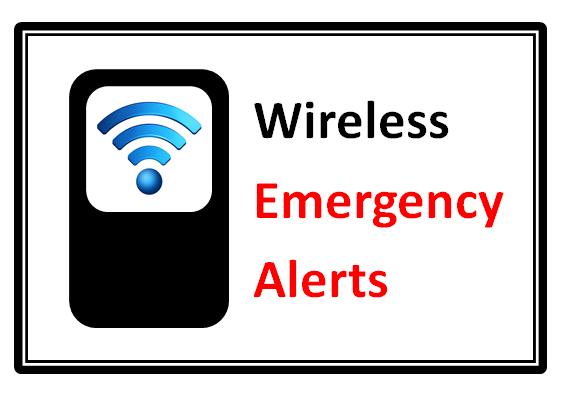
What types of alerts will I receive?
- Extreme weather, and other threatening emergencies in your area
- AMBER Alerts
- Presidential Alerts during a national emergency
What does a WEA message look like?
WEA will look like a text message. The WEA message will show the type and time of the alert, any action you should take, and the agency issuing the alert. The message will be no more than 90 characters.
How will I know the difference between WEA and a regular text message?
WEA messages include a special tone and vibration, both repeated twice.
What types of WEA messages will the National Weather Service send?
- Tsunami Warnings
- Tornado and Flash Flood Warnings
- Hurricane, Typhoon, Dust Storm and Extreme Wind Warnings
- Blizzard and Ice Storm Warnings
What should I do when I receive a WEA message?
Follow any action advised by the emergency message. Seek more details from local media or authorities.
Will I receive a WEA message if I’m visiting an area where I don’t live, or outside the area where my phone is registered?
Yes, if you have a WEA-capable phone and your wireless carrier participates in the program. For information about which mobile devices are WEA-capable and carrier participation, please visit http://www.ctia.org/wea or contact your wireless carrier.
What if I travel into a threat area after a WEA message is already sent?
If you travel into a threat area after an alert is first sent, your WEA-capable device will receive the message when you enter the area.
When will I start receiving WEA messages?
It depends. WEA use begins in the spring of 2012, but many mobile devices, especially older ones, are not WEA-capable. When you buy a new mobile device, it probably will be able to receive WEA messages. For information about which mobile devices are WEA-capable, please visit http://www.ctia.org/wea or contact your wireless carrier.
Is this the same service public safety agencies have asked the public to register for?
No, but they are complementary. Local agencies may have asked you to sign up to receive telephone calls, text messages, or emails. Those messages often include specific details about a critical event. WEA are very short messages designed to get your attention in an emergency situation. They may not give all the details you receive from other notification services.
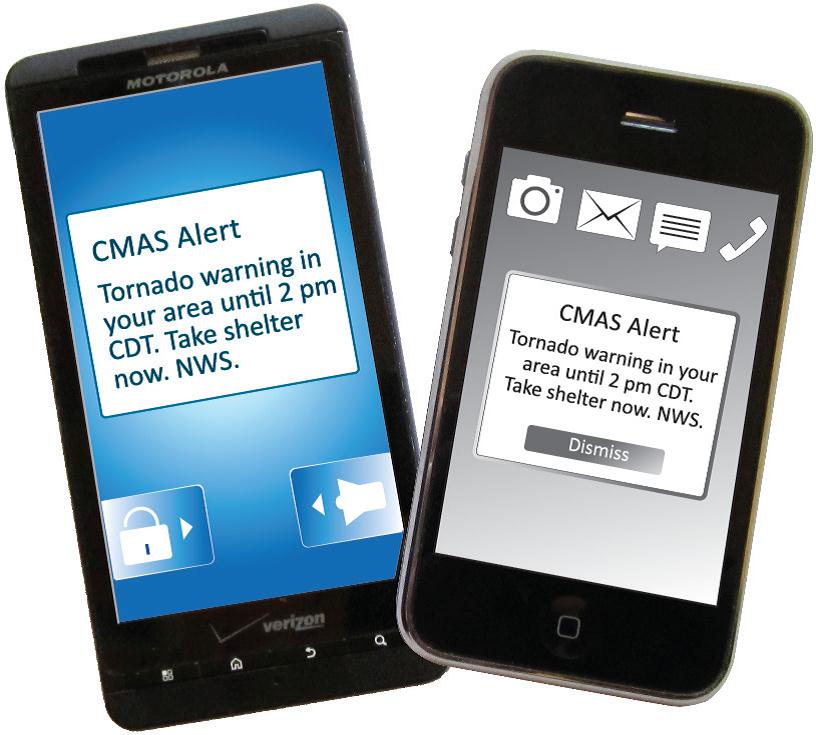
Will I be charged for receiving WEA messages?
No. This service is offered for free by wireless carriers. WEA messages will not count towards texting limits on your wireless plan.
Does WEA know where I am? Is it tracking me?
No. Just like emergency weather alerts you see on local TV, WEA are broadcast from area cell towers to mobile devices in the area. Every WEA-capable phone within range receives the message, just like every TV shows the emergency weather alert if it is turned on. TV stations, like WEA, don’t know exactly who is tuned in.
Will a WEA message interrupt my phone conversations?
No, the alert will be delayed until you finish your call.
How often will I receive WEA messages?
You may receive frequent WEA messages during an emergency. Message frequency depends on the number of imminent threats to life or property in your area.
If, during an emergency, I can’t make or receive calls or text messages due to network congestion, will I still be able to receive a WEA message?
Yes, WEA messages are not affected by network congestion.
What if I don’t want to receive WEA messages?
You can opt-out of receiving WEA messages for imminent threats and AMBER alerts, but not for Presidential messages. To opt out, please refer to instructions from your wireless carrier or visit http://www.ctia.org/wea for more information.
How will I receive alerts if I don’t have a WEA-capable device?
WEA is one of many ways you can receive emergency notifications. Other sources include NOAA Weather Radio, news media coverage, the Emergency Alert System on radio and TV broadcasts, social media, and other alerting methods offered by local and state public safety agencies. Your best use of WEA is to immediately seek additional information about the imminent threat impacting your area.
A flyer with more information about
Wireless Emergency Alerts is available.
Safe Room Q & A
What is a safe room? What are the design requirements for a FEMA safe room?
A safe room is a hardened structure specifically designed to meet FEMA criteria and provide "near-absolute protection" in extreme weather events, including tornadoes and hurricanes. The level of protection provided by a safe room is a function of its design parameters, specifically the design wind speed and resulting wind pressure and the wind-borne debris load resistance. To be considered a FEMA safe room, the structure must be designed and constructed to the guidelines specified in FEMA P-320, Taking Shelter
from the Storm: Building a Safe Room for Your Home or Small Business (FEMA, third edition, 2008a) (for home and small business safe rooms). Additionally, all applicable Federal, State, and local codes must be followed. When questions arise pertaining to the differences between FEMA P320 criteria and another code or standard, the most conservative criteria should apply.
Should I have a safe room?
Pages 6 through 10 of FEMA P-320 (FEMA, 2008a) provide background information to help homeowners decide if a safe room is needed in their home. Homeowners and small-business owners should also refer to the Homeowner’s Worksheet, Assessing Your Risk (Table I-1) in FEMA P-320 (FEMA, 2008a); this is an easy-to-use matrix that helps users decide whether a safe room is a matter of preference, should be considered, or is the preferred method for protection from extreme winds.
My house has a basement. Do I need a safe room?
Some strong tornadoes have resulted in loss of floor framing, collapse of basement walls, and death and injuries to individuals taking refuge in a basement. What constitutes an acceptable level of protection is an individual decision. A basement may be the safest place to seek shelter for homes without a safe room, but it will not provide the same level of protection as a safe room unless it has been designed and constructed to provide the level of protection in accordance with FEMA P-320 (FEMA, 2008a) and FEMA P-361 (FEMA, 2008b).
A basement is a good location to install a shelter or build a safe room, but access for handicapped or physically challenged individuals may be limited. The flood risk of your location may also affect whether it is appropriate to place a safe room in your basement. If your house or neighborhood is prone to flooding, the basement may not be an appropriate location for taking refuge.
Where can I find information about obtaining FEMA funding to construct a safe room? Are there any funds available in my area?
For project eligibility and financial assistance questions, please contact your Local Emergency Manager. Your Emergency Manager can advise you on what information must be provided for your project to be considered for funding, as well as any applicable Federal, State, and local design requirements.
Can I still apply for FEMA funding after I have begun construction of a safe room or purchased a safe room?
No. You must apply for funding before the purchase of a safe room or beginning any construction. Section D.2, Part III of FY 2011 Hazard Mitigation Assistance Unified Guidance (FEMA, 2010) states that costs related to projects for which actual physical work (such as groundbreaking, demolition, or construction of a raised foundation) has occurred prior to award or final approval are ineligible.
What costs are eligible for funding under a safe room grant?
Allowable costs for safe room projects funded under FEMA’s Hazard Mitigation Grant Program (HMGP) are those components related to, and necessary for, providing life safety for building residents in the immediate vicinity during an extreme-wind event. The funding covers design and building costs related to structural and building envelope protection. The funding covers both retrofits to existing facilities and new construction projects, and applies to both single- and multi-use facilities.
Eligible costs are only those consistent with FEMA-approved performance criteria as provided in FEMA P-320 (FEMA, 2008a). These criteria are summarized in Table 6 (below) of the 2011 FY FEMA Hazard Mitigation Assistance Unified Guidance (FEMA, 2010). (Click the table to view it larger.)

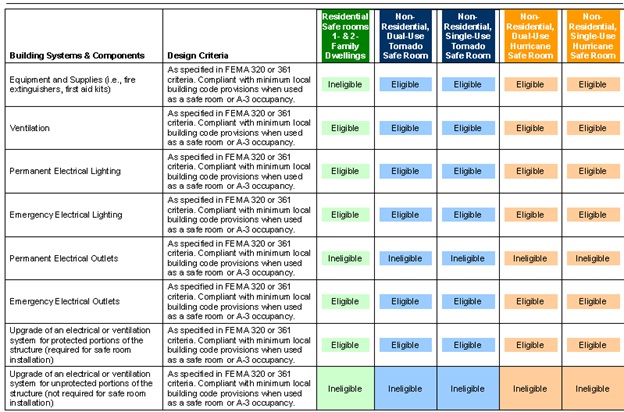
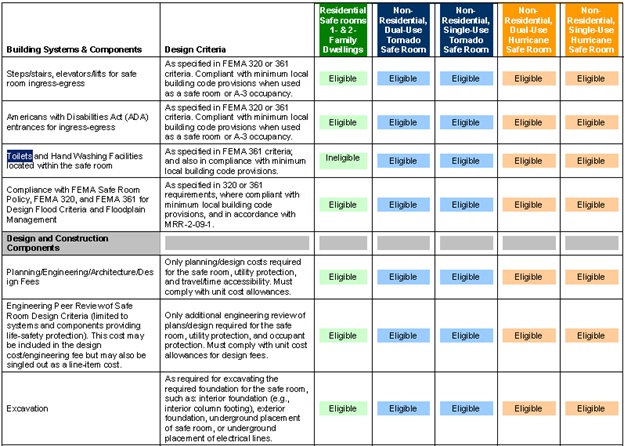
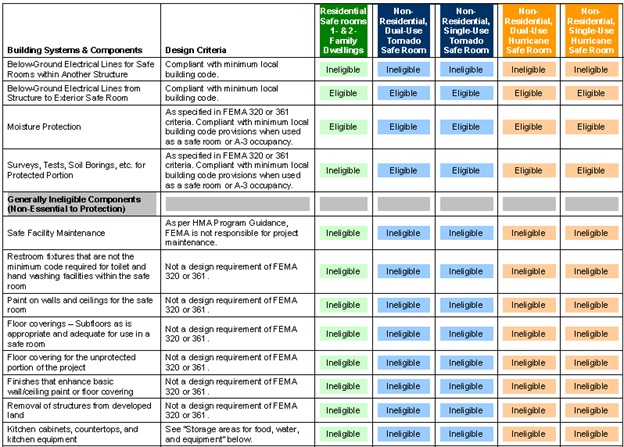
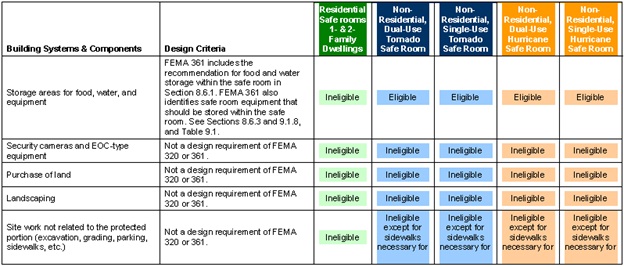
Does FEMA approve, endorse, or certify any products?
No. Federal No. Federal policy does not allow FEMA to approve, endorse, certify, or recommend any products. While a product may be in compliance with FEMA design guidance, any language from manufacturers stating their product is "FEMA approved" or "FEMA certified" is incorrect.
What is the recommended square footage per person for a residential tornado and hurricane safe room?
For residential safe rooms, the usable tornado safe room floor area should be the gross floor area minus the area of sanitary facilities, if any, and should include the protected occupant area between the safe room walls at the height of any fixed seating, if it exists. The minimum recommended safe room floor area per occupant for residential tornado and hurricane safe rooms is provided in table below. (Click the table to view it larger.)

What is the cost of installing a safe room in a new home or small business?
Costs for construction vary across the United States. The cost for constructing a safe room that can double as a master closet, bathroom, or utility room inside a new home or small business ranges from approximately $6,600 to $8,700 (in 2011 dollars). This cost range is applicable to the basic designs in FEMA P-320 (FEMA, 2008a) for an 8-foot by 8-foot safe room (approximately 64 square feet of protected space). Larger, more refined designs for greater comfort cost more, with 14 foot by 14-foot safe rooms ranging in cost from approximately $12,000 to $14,300. The cost of the safe room can vary significantly, depending on the following factors:
- The size of the safe room
- The location of the safe room within the home or small business
- The number of exterior home walls used in the construction of the safe room
- The type of door used
- The type of foundation on which the safe room is constructed
- The location of the home or small business within the United States
For additional cost information for small safe rooms in a home or small business, see FEMA P-320 (FEMA, 2008a), Section II, page 34.
As a homeowner, can I build the safe room on my own?
A homeowner who builds a safe room should be skilled in building construction. Some pre-fabricated safe rooms are available that require less building construction experience to successfully install. In purchasing any safe room, the homeowner should obtain sufficient documentation to determine that the safe room is built to the FEMA safe room design and protection criteria.
Can I install a safe room in an existing home?
Yes, though installing a safe room in an existing home or small business is typically more expensive and challenging than installing one in a new building. Modifying the walls or foundation of an existing building for the construction of a safe room is more complicated than constructing those elements new and, as a result, some of the prescriptive safe room designs provided in FEMA P-320 (FEMA, 2008a) are not practical for some existing homes. Typically, installing a safe room in an existing home costs 20 percent more than installing the same safe room in a new home under construction.
Due to the technical challenges involved in retrofitting an existing home for a safe room,
an architect or engineer should be consulted to address the structural issues and the wind-borne debris protection criteria, even when not required by the local building department. As such, homeowners must balance the desire to have protection within their home with the practicality of constructing a safe room outside the footprint of their existing home or structure for less money. For more information on retrofitting existing buildings with a safe room, see FEMA P-320 (FEMA, 2008a), Section II, page 25.
Is an underground safe room safer than one above ground?
As long as a safe room is designed to meet or exceed the criteria in FEMA P-320 (FEMA, 2008a) and FEMA P-361 (FEMA, 2008b), it will offer the same near-absolute protection whether it is above or below ground.
Where is the best location for the safe room?
There are several possible locations in or near your home or small business for a safe room. The most convenient location in many homes is in the basement. If there is no basement within the home, or if the walls of the basement do not meet FEMA P-320 (FEMA, 2008a) design criteria, an in-ground safe room can be installed beneath a concrete slab-on-grade foundation or concrete garage floor. In-ground and basement safe rooms provide the highest level of protection against missiles and falling debris because they are typically shielded from direct forces of wind and debris; however,
above-ground designs, such as the prescriptive designs provided in FEMA P-320 (FEMA, 2008a) or any solution following the criteria set forth in FEMA P-361 (FEMA, 2008b) will provide near-absolute protection.
Many individuals prefer to build within their homes or buildings so they have some level of
protection while attempting to access their safe room. For an existing home or small business, this convenience must be balanced with the challenges of retrofitting the building. For more information on selecting the location of a safe room within your home or small business, see FEMA P-320 (2008a), Section II, page 27.
Are inspections required?
Obtaining proper building permits and inspections is important for all construction. The builder or homeowner should ensure the safe room is built according to the plans in FEMA P-320 (FEMA, 2008a) or to plans that, through testing and engineering, have been determined to meet the safe room design criteria in FEMA P-320 (FEMA, 2008a) or FEMA P-361 (FEMA, 2008b). The level of construction needed for a safe room typically requires a permit from the local building department. Further, to verify compliance with the FEMA or International Code Council (ICC)-500 (ICC, 2008) criteria, additional quality control inspections for community safe rooms, and often for residential safe rooms, may be needed.
If the Storm shelter costs $6,000.00 can I get more than $2,000 reimbursed?
No, the Hazard Mitigation Program only allows reimbursements up to 75% of the approved costs.
I need to have my Storm Shelter money up front to pay my contractor. Is this possible?
No, The money is only available as a reimbursement, AFTER construction is completed and you have submitted signed and notarized documentation from your contractor stating your Storm Shelter meets or exceeds the specification set forth in FEMA Publication 320.
If I am eligible to receive the $2,000 rebate, do I have to consider that money as income for State and Federal Income Tax purposes?
No, in accordance with the Robert T. Stafford Disaster Relief and Emergency Assistance Act, as amended, these funds are considered free from tax liability under Federally funded assistance programs.
Pets & Animals in a Disaster
Whether it's a large-scale natural catastrophe or an unforeseen emergency that causes you to leave your home temporarily, everyone's family can benefit from having a household evacuation plan in place before disaster strikes.
Every disaster plan must include your pets!
The Humane Society of the United States (HSUS) offers the following tips to pet owners designing an emergency safety plan:
- If you evacuate your home, DO NOT LEAVE YOUR PETS BEHIND! Pets most likely cannot survive on their own; and if by some remote chance they do, you may not be able to find them when you return.
- For public health reasons, many emergency shelters cannot accept pets. Find out which motels and hotels in your area allow pets -- well in advance of needing them. Include your local animal shelter's number in your list of emergency numbers -- they might be able to provide information concerning pets during a disaster.
- Make sure identification tags are up to date and securely fastened to your pet's collar. If possible, attach the address and/or phone number of your evacuation site. If your pet gets lost, his tag is his ticket home. Make sure you have a current photo of your pet for identification purposes.
- Make sure you have a secure pet carrier, leash or harness for your pet so that if he panics, he can't escape.
- Take pet food, bottled water, medications, veterinary records, cat litter/pan, can opener, food dishes, first aid kit and other supplies with you in case they're not available later. While the sun is still shining, consider packing a "pet survival" kit, which could be easily deployed if disaster hits.
- If you are unable to return to your home right away, you may need to board your pet. Most boarding kennels, veterinarians and animal shelters will need your pet's medical records to make sure all vaccinations are current. Include copies in your "pet survival" kit along with a photo of your pet.
- If it is impossible to take your pet with you to temporary shelter, contact friends, family, veterinarians, or boarding kennels to arrange for care. Make sure medical and feeding information, food, medicine and other supplies accompany your pet to his foster home. NOTE: Some animal shelters will provide temporary foster care for owned pets in times of disaster, but this should be considered only as a last resort.
- If you have no alternative but to leave your pet at home, there are some precautions you must take, but remember that leaving your pet at home alone can place your animal in great danger! Confine your pet to a safe area inside -- NEVER leave your pet chained outside! Place a notice outside in a visible area, advising what pets are in the house and where they are located. Provide a phone number where you or a contact can be reached as well as the name and number of your vet.

Not only are pets affected by disaster, but the other animals in the disaster area are affected as well. The HSUS offers these basic tips for people who encounter wildlife or have livestock on their property:
Wildlife
- Wild animals often seek higher ground, which, during floods, eventually become submerged (i.e., island) and the animals become stranded. If the island is large enough and provides suitable shelter, you can leave food appropriate to the species (i.e., sunflower seeds for squirrels). Animals have a flight response and will flee from anyone approaching too closely. If the animal threatens to rush into the water, back away from the island or you may frighten the animal into jumping into the water to escape from you
- Wildlife often seek refuge from flood waters on upper levels of a home and may remain inside even after the water recedes. If you meet a rat or snake face to face, be careful but don't panic. Open a window or other escape route and the animal will probably leave on its own. Never attempt to capture a wild animal unless you have the training, protective clothing, restraint equipment and caging necessary to perform
the job.
- Beware of an increased number of snakes and other predators who will try to feed on the carcasses of small mammals who have been drowned or crushed in their burrows or under rocks.
- Often, during natural disasters, mosquitoes and dead animal carcasses may present disease problems. Outbreaks of disease may occur. The local public health office will issue news releases to assist with aiding the public regarding health issues associated with the disaster.
- If you see an injured or stranded animal in need of assistance, or you need help with evicting an animal from your home, please contact your local animal control office or Nebraska Games and Parks.
Livestock
Evacuate Livestock Whenever Possible.
- Arrangements for evacuation, including routes and host sites, should be made in advance. Alternate routes should be mapped out in case the planned route is inaccessible.
- The evacuation sites should have or be able to readily obtain food, water, veterinary care, handling equipment and facilities.
- Trucks, trailers, and other vehicles suitable for transporting livestock (appropriate for transporting each specific type of animal) should be available along with experienced handlers and drivers to transport them. Whenever possible, the animals should be accustomed to these vehicles in advance so they're less frightened and easier to move.
- If evacuation is not possible, a decision must be made whether to move large animals to available shelter or turn them outside. This decision should be determined based on the type of disaster and the soundness and location of the shelter (structure).
- All animals should have some form of identification that will help facilitate their return.
Your disaster plan should include a list of emergency phone numbers for local agencies that can assist you if disaster strikes -- including your veterinarian, state veterinarian, local animal shelter, animal care and control, and county extension service. These numbers should be kept with your disaster kit in a secure, but easily accessible place.
For additional information, please contact:
The Humane Society of the United States
2100 L. Street, NW
Washington, DC. 20037
Attn: Disaster Services Program
Phone: (202) 452-1100
Website: http://www.hsus.org
Policy for Subdivision Road Maintenance
Buffalo County will (may) provide public road top only maintenance
within established subdivisions on the following basis:
Subdivision must be properly platted and recorded with established
roads dedicated to the public.
Subdivision must present the County Board of Commissioners
a petition for such maintenance signed by a majority of property
owners.
Maintenance will be on a "Low-priority" basis,
as compared to "Regular or High-priority" main roads,
school bus routes, emergency roads, section line and half section
line roadways.
The County may require the subdivision to improve roads to
minimum standards if there is difficulty operating maintenance
vehicles because of such conditions. The cost of their improvement
or any other significant road improvements shall be the financial
responsibility of the subdivision.
Each subdivision should have an alternate snow removal plan
in the event that emergency situations dictate the use of
equipment elsewhere.
It is further recommended that each subdivision's governing
body or committee appoint one representative within the subdivision
to communicate problems or questions to the County Road Department.
Shelter in Place
What is Shelter-in-Place?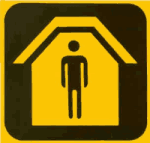
In a situation where a serious hazardous chemical spill has quickly caused a toxic atmosphere, it may be more dangerous to go through those toxic vapors or to attempt to outrun them than to stay in an existing structure. Shelter-in-Place means to get to the inside of a building and remain there during a chemical emergency rather than attempting to evacuate the area. Shelter-in-Place is a viable option for protection against exposure to potentially dangerous airborne chemicals during an emergency.
Why Should I Shelter-in-Place?
During a hazardous materials incident, the idea is to keep everyone's exposure to any chemical as low as possible. It is best to get out of the area and have no exposure, but in a sudden chemical release there may not be time to safely evacuate. In such cases, attempts to evacuate could place you at greater risk of exposure than if you had stayed in your home or workplace. Shelter-in-place is used when there has been a serious hazardous chemical spill that has quickly caused a toxic atmosphere and there is not enough time to safely leave the area. When you shelter-in-place, you take protective action in a structure to reduce exposure to toxic chemical levels. So, unless otherwise instructed to evacuate, sheltering-in-place could be the best way to safely wait out a hazardous chemical release.
How safe is it to Shelter-in-Place?
In a 2001 report by The National Institute for Chemical Studies, several studies were cited that demonstrate the value of sheltering-in-place during a chemical emergency. In older homes, the average house was found to change its air at a rate of less than 1/3
change per hour. It was also found that if one room in the house was sealed up with duct tape and plastic, the amount of chemical that was in the room after one hour was between 1/7 to 1/17 of what was outside. Another study found that sealing up a house also filtered out some of the chemicals. Not only did a sealed up house limit the amount of air coming into a house, the walls actually did some filtering of the air that seeped in. Sheltering-in-place cannot completely eliminate all exposure to the chemical, but it can keep the exposure below dangerous levels.
The report concluded: "For the vast majority of events that have led to the public to shelter-in-place, there have been no reported injuries. In fact, for a very few cases, clouds of toxic materials of sufficient concentration to cause harm have entered communities and, because sheltering-in-place has been accepted by the community and was successfully implemented, no one was injured. The body of evidence suggests that
if there is insufficient time to complete an evacuation, or the chemical leak will be of limited duration, or conditions would make an evacuation more risky than staying in place,
sheltering-in-place is a good way to protect the public during chemical emergencies."
When should I Shelter-in-Place?
A hazardous materials accident can occur anywhere. There may even be a time when you are close to where a chemical accident has taken place. If you feel or hear a strange sound like an explosion; if you see a strange cloud; if you smell a strange odor; if you feel nauseous or have burning or tearing eyes; trust your senses, don't wait for a warning confirmation and act immediately. If it is obvious that you can safely evacuate the area, do so, but remember shelter-in-place as the next option.
In Buffalo County Monitor:
|
KGFW/KQKY
|
1340 AM
|
105.9 FM
|
|
KKPR
|
1460 AM
|
98.9 FM
|
|
KHGI-TV (NTV)
|
|
Channel 13
|
|
NOAA weather radio
|
|
162.475
|
If there is a chemical release in Buffalo County, the emergency alert system will be utilized. The outdoor warning sirens will sound to alert the public to turn on a radio or television for further emergency information.
Where do I Shelter-in-Place?
If you are told to shelter-in-place or if you believe you need to, you should go inside any building close by immediately. If you are not by your own house, a church, school, or store are good options. If you are not near any buildings, your car is a better choice than staying outside. Your home is the best choice to shelter-in-place because you will know
where tapes, towels, plastics and other items are located to help you create your shelter space.
How do I Shelter-in-Place?
- Close all doors to the outside and close and lock all windows (windows sometimes seal better when locked.)
- Ventilation systems should be turned off so no outside air is drawn into the structure.
- Turn off all heating systems and all air-conditioners and switch inlets to the "closed" position.
- Seal any gaps around window type air-conditioners with tape and plastic sheeting, wax paper, or aluminum wrap.
- Turn off all the exhaust fans in kitchens, bathrooms and attics, and cover the openings with plastic wrap or plastic sheeting.
- Close all fireplace dampers and seal with plastic if possible.
- Close as many internal doors as possible in the structure you are in.
- Pick a room on the highest level of the structure, as most of the chemicals that are of concern are heavier than air and will settle in the basement.
- Select a room in the building that is comfortable and easy to seal off. The room should, if possible, provide access to water, toilet facilities, and have adequate room for people and pets to sit.
- If the vapor begins to bother you place a wet cloth over your nose and mouth. For a higher degree of protection, go into the bathroom, close the door and turn on the shower in a strong spray to "wash" the air. Seal any opening to the outside of the bathroom as best you can.
- Make sure you have a battery-powered radio and a flashlight in case the power goes out.
- Once in the room, seal windows, air vents, and exhaust fans with plastic sheeting and duct tape.
- In some homes, light switches and electrical outlets on outside walls are sources of air infiltration and should also be sealed with duct tape and plastic.
- Lastly, seal around the door with duct tape. If the space under the door is too big to seal with tape, try stuffing a damp towel under the door.
- Continue to listen to the radio or TV for emergency information and updates on the incident.
- Don't call 911 unless you have an emergency like a fire or a serious injury.
- Keep your phone available in case someone needs to contact you.
What if I can't make it to a building?
If you can get to your car, go there. Turn off the ventilation system, close your windows and vents, and tune your radio to a local station. If you are driving, try to avoid driving
through a vapor cloud and try to drive crosswind. If you are in a chemical cloud, be aware that your car may stall. If your car stalls or was not running when enveloped by the cloud, DO NOT try to start it unless told to do so by a public announcement on the radio.
If you are outside and not close to a building, such as being on a golf course or in a rural area, try to move crosswind. The vapors may drift downwind for miles and unless there is no wind at all you will not be able to outrun them. Going perpendicular to the wind, away from the center of the cloud will get you to a less harmful atmosphere quicker.
How will I know when it is safe to come out?
As soon as it is deemed safe, authorities will tell you it is safe to leave your building.
Disaster Supplies to have on hand:
- Flashlight and extra batteries
- Portable battery-operated radio
- Duct tape and plastic sheeting & wrap
- Games and toys to occupy children
- First aid kit and essential medicines
- Emergency food and water
SPECIAL NOTE: SHELTER-IN-PLACE DOES NOT APPLY TO FLAMMABLE GASES SUCH AS PROPANE AND NATURAL GASES.
Subdivision Road Specifications, RL-3
Minimum Right of Way-66 feet requirement
Design Speed (MPH)-30 MPH or less
Maximum Curve (degree)-23.0 degree
Maximum Grade (%)-10%
Number of Lanes-2
Lane Width-10 feet each
Shoulder Width (feet)-3 feet
Lateral Obstacle Clearance (feet)-5 feet
Surface Type Minimum--Gravel
Drainage Facilities
Buffalo County will require the number of structures to
accommodate adequate water drainage (culverts and bridges), as well
as adequate drainage ditches to insure a safe travel surface for the
traveling public. The County will not be responsible for any drainage
structures that have not met requirements.
Turn Arounds
Minimum radius of 66.0 feet on dead end roads for adequate machine
turn arounds.
Signing
Proper signing will be required on intersections within the
subdivision as well as on main roads outside and/or leading into a
subdivision. This includes proper dead end signs, obstacle markers and
speed signs.
Driveways
Paved and hard surfaced driveways will be the responsibility of the landowner
in the event of any reconstruction or maintenance work. New driveways within
the subdivision are the responsibility of the landowner. Landowners must obtain
a driveway permit from the County Highway Department, whereupon the Highway
Department will check the location for drainage and/or culvert size. If a
culvert is required, it will be the responsibility of the landowner to purchase
the culvert and install it.
Trees, Etc.
Trees, shrubbery or flowers will not be allowed within the 66.0 feet of
right of way, nor will fences be allowed within this right of way.
Snow Removal
Snow removal will consist of the traveled surface only as low priority.
Driveways will be the responsibility of the landowner or tenant.
Maintenance
Those gravel roads within the subdivision will be treated as low priority
as compared to other County gravel roads. Paved or hard surface roadways within
the subdivision will be the responsibility of the subdivision as far as maintenance,
patching, resurfacing or complete reconstruction. Buffalo County will assume snow
removal of the traveled roadway only. Any outside construction or maintenance work
done on those roads within the subdivision by a contractor or resident will not be
the responsibility of Buffalo County liability and/or cost.
For additional information, please contact the Highway Department at 308-236-1237.
Voter Registration
Nebraska VoterCheck Website
Click the above link to access your polling place address and party affiliation if you are already registered
Nebraska Online Voter Registration
Click the above link to register to vote, change your address, party affiliation or change your name on your voter registration record.
Is registration required in Nebraska to be eligible to vote?
Yes, the only exception is during Presidential elections. If you have recently moved to Nebraska or moved to another state after the registration deadline, then you may only vote a Presidential ballot.
Who may register to vote?
Anyone who meets the following criteria:
- Will be 18 years of age or older on General Election Day (first Tuesday after the first Monday in November)
- Is a United States Citizen
- Is a resident of Nebraska
- Has not been convicted of a felony or, if convicted it has been at least two years since I completed my sentence for the felony, including any parole term
- Have not been found mentally incompetent
How may I register?
You may register at the Election Commissioner's Office from 8:00 a.m. to 5:00 p.m. Monday through Friday. You may also download the form and send it by mail if you
have access to a printer (see instructions on the right) or click on the link above
that says Nebraska Online Voter Registration.
What is the registration deadline?
Mail-in registration must be postmarked on or before the third Friday before an election. You may register in person at the Election Commission by the second Friday prior to an election.
Do I have to be a resident for a certain time period?
No, you may register the same day you become a resident of Buffalo County.
How is residence determined?
Residence shall mean:
- That place in which a person is actually domiciled, which is the residence of an individual or family, with which a person has a settled connection for the determination of his or her civil status or other legal purposes because it is actually or legally his or her permanent and principal home, and to which, whenever he or she is absent, has the intention of returning.
- The place where a person has his or her family domiciled even if he or she does business in another place.
- If a person is homeless, the county in which the person is living.
No person serving in the armed forces of the United States shall be deemed to have a residence in Nebraska because of being stationed in Nebraska. Those serving in the military or attending college in another area other than Buffalo County do not need to change their registration. However, any permanent change in your residence or address will require you to re-register to vote in that location.
May a student register and vote from a school address?
Yes, you may decide to register and vote from either your school or home address. If you want to vote from your home address, write your county election commissioner or clerk and ask them to mail a voter registration form and an absentee ballot. (See Absentee Ballot information)
Must I designate a party affiliation on my registration?
Yes. Nebraska has a "closed primary" which means that you are only allowed to vote the ballot for the party you designated on your voter registration. Currently Nebraska has Republican, Democrat, Libertarian, Non-partisan, and Marijuana NOW. If you are registered as one of the above parties, you would receive the party ballot along with the non-partisan ballot. You may indicate that you wish to be Non Partisan, but in that event, you would only receive the non-political ballot and (if you request) a congressional and senatorial partisan ballot. You may change your party affiliation anytime before the registration deadline.
Do I ever have to re-register?
You must re-register whenever you change your name, your address or political party affiliation.
Will I receive notice that my mail-in registration has been accepted and processed?
Yes, if you completed the form correctly and mailed it by the deadline (third Friday prior to an election). If you do not receive notification within 10 days that your registration has been accepted, call the Election Office. You are not a registered voter until you receive confirmation.
Planning & Zoning Commission
Office Hours: Monday - Friday: 8:00 a.m. - 5:00 p.m.
2025 Planning and Zoning Commission Deadlines and Meeting Times
2025 Board of Commissioners Deadlines & Meeting Times
Objectives
• Review and recommend, to the County Board, the enactment and amendment of Buffalo County’s Zoning Map, Zoning Code, and Subdivision Code. Also this Commission conducts population, housing, and growth studies of Buffalo County and its rural areas. From this study, the Commission formulates Buffalo County’s Comprehesive Plan. That Plan provides to the Commission and this county a direction as to future growth and development for Buffalo County’s unincorporated and rural areas, including any Zoning Map or Code Amendments that be needed to pursue the goals of the Comprehensive Plan.
• Analyze and submit recommendations of approval or disapproval, of any applications regarding Subdivisions of any Development-Type Operations and Special Uses as identified in the County’s Zoning Code and Subdivision Code to the Buffalo County Board of Commissioners.
• Public meetings are held on the third Thursday of each month, at 7:00 p.m., at the Buffalo County Courthouse, unless otherwise posted.
|
Note: Government Offices can only accept written documents for filing into official government records unless specific statutory language authorizes filings done by other than written medium.
|
|
Fees:
| Filing |
Fee |
| *Zoning permits |
$100.00 ****** |
| *Conditional/Special Use permits |
$50.00 plus estimated cost of publication |
| *Rezoning |
75.00 plus estimated cost of publication posted at time of filing |
| *Amendments to Comprehensive Plan, Zoning Regulations, Subdivision Regulations and Zoning map |
$75.00 in each instance plus estimated cost of publication posted at time of filing |
| *Variances submitted to Board of Zoning Adjustment |
$100.00 plus estimated cost of publication posted at time of filing |
**Administrative Subdivision Fees for Buffalo County:
| Filing |
Fee |
| Filing with Zoning Administrator |
$300.00 plus estimated cost of publication at time of filing ****** |
Modifications after filing
Plus filing fees set by Register of Deeds |
$150.00 plus estimated cost of publication at time of filing ******
|
| Plus per lot fee of |
$50.00 ****** |
**Non-Administrative Subdivision Fees for Buffalo County:
| Filing |
Fee |
| Preliminary Plat |
$200.00 *** ****** |
| Final Plat (applied each portion if staged) |
$100.00 *** ****** |
| Plus per lot fee of |
$50.00 |
**Other Processes or Events Fees for Buffalo County:
| Filing |
Fee |
| Minor Subdivision Changes |
$100.00 plus estimated cost of publication at time of filing ****** |
| Vacation of Plat or part thereof |
$250.00 plus estimated cost of publication at time of filing
$125.00 plus estimated cost of publication at time of filing for administrative subdivisions ***** |
| Variance |
$100.00 plus estimated cost of publication at time of filing ****** |
| Fee if public hearing postponed |
$50.00 |
| Fee for process if not otherwise stated |
$50.00 |
****Conservation or Preservation Easements Fees for Buffalo County:
| Fee |
| $125.00 or $2.00 per acre, whichever is greater |
Plus filing fees set by Register of Deeds unless Code states otherwise
*Passed at Board of Supervisors meeting on May 28, 2002
**Passed at Board of Supervisors meeting on February 24, 2009
***Passed at Board of Supervisors meeting on September 14, 2010
****Passed at Board of Supervisors meeting on November 23, 2010
*****Passed at Board of Supervisors meeting on June 11, 2013 retroactive to May 14, 2013
******Passed at County Commissioners meeting on April 25, 2017 effective July 1, 2017
Disclaimer Statement
NOTICE
The information provided by this service resides on a computer system funded by the County of Buffalo, Nebraska. Anyone using this service consents to the monitoring of their use of this service by the computer system providers, authorized County of Buffalo, Nebraska employees, as well as security or law enforcement personnel. Communications made through this service's electronic mail and Messaging system shall, in no way be deemed to constitute a filing with or legal notice to the County of Buffalo or any of its agencies, departments, authorities, officers, directors, employees, agents or representatives, with respect to any existing or potential claim or cause of action against the County or any of its agencies, departments, authorities, officers, directors, employees, agents or representatives, where notice to the County is required by any federal, state or local law, rule or regulation.
Government Offices can only accept written documents for filing into official government records unless specific statutory language authorizes filings done by other than written medium.
PRIVACY POLICY
The protection of individual privacy is a concern to Buffalo County. Buffalo County has created this privacy statement in order to demonstrate its firm commitment to privacy. The following discloses our information gathering and dissemination practices for this site.
Information You Provide to Us:
Buffalo County does not keep any personal information about you or your visit to our Internet site unless you have specifically supplied it to us. If you may have supplied us with information as part of a request for information or to e-file an appeal of your Board of Property Assessment decision. This also applies to any feedback or on-line survey information you may have sent us through our website. In cases where you have supplied us with information, including financial data, we will treat such information in accordance with the requirements of the law. This means that it will be treated in the same way as written forms of communication, and in many instances it will be considered public information available to the public upon request. To the extent allowed by law, Buffalo County will make reasonable attempts to protect personal financial information from disclosure.
Public Disclosure:
As a general rule, Buffalo County does not disclose any personally identifiable information collected online except where you have given us permission or where the information is public information under the Nebraska Public Records Act et seq., or other applicable laws. Visitors should be aware that information collected by the County on its websites may be subject to examination and inspection if such information is a public record and not otherwise protected from disclosure.
Other Information about Your Visit to Our Site:
Our web site does not automatically collect any information from your computer during your visit. Certain pages, however, may tally total number of visitors.
This privacy policy does not apply to web sites operated by third parties that you may access through a link from our web site.
DISCLAIMER OF WARRANTIES
The County of Buffalo makes no warranty or representation, express or implied, including but not limited to warranties of merchantability and fitness for a particular purpose. The County of Buffalo assumes no liability or responsibility for the quality, content, accuracy, completeness of the information, text, graphics, links and any other items contained on this service or any other system or service. The materials contained on this service have been compiled from a variety of sources and are subject to change without notice. Commercial use or sale of the materials contained on this service is prohibited without the express written consent of the County of Buffalo. In no event will the County of Buffalo be liable for any damages whatsoever, whether direct, indirect, consequential, incidental or special, or any claim for attorney's fees arising out of the use or inability to use the information on this service, even if the County of Buffalo is advised of the possibility of such damages.
COPYRIGHT STATUS
All documents available on this service may be protected under the United States and/or Foreign Copyright Laws. Permission to reproduce may be required. The County of Buffalo retains all rights to the information provided by this service, including, but not limited to, the right of reproduction.
DISCLAIMER OF ENDORSEMENT
Reference herein to any specific commercial products, process, or service by trade name, trademark, manufacturer, or otherwise, does not necessarily constitute or imply its endorsement, recommendation, or favored status by the County of Buffalo. The views and opinions of authors expressed on this service do not necessarily state or reflect those of the County of Buffalo, and shall not be used for advertising or product endorsement purposes.
The County of Buffalo is not, and shall not bear any responsibility for the contents of any off-site pages referenced.
Welcome
We invite you to browse our web site to learn about our various County offices and the services Buffalo County, Nebraska offers its citizens.
LB304 - Annual Memberships
Follow us on for current info as well. for current info as well.
This web site contains information about County programs,services, departments and offices, as well as helpful information oncommonly asked questions. We encourage you to use this site frequently to access meeting notices, Open Meetings Act, agendas, packets, and minutes of the County Board of Commissioners.
Buffalo County uses Beacon Bid to share solicitations with suppliers. Click on any solicitation and fill out the free form on Beacon. Or subscribe for free updates for our future bids and RFPs. You will receive an email with the link to download attachments. Please note that accurate contact information is required in order to receive any updates.
Beacon is free for bidders.
|